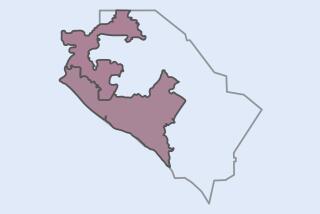U.S. Jury Pool Change Angers Lawyers in O.C.
- Share via
SANTA ANA — A new jury selection system that draws prospective federal jurors from Orange County but not from neighboring counties has angered defense attorneys, who complain that the change will further exclude blacks and lead to more all-white juries.
The change begins Sept. 5 at U.S. District Court here, where jurors for federal trials will be selected exclusively from Orange County’s voter registration rolls. The jury pool will no longer include people from Riverside and San Bernardino counties.
Court officials said the new system was prompted by the opening of a new federal court in Riverside and will make it more convenient for jurors because they will no longer have to travel long distances. The federal government, which routinely reimburses hotel and travel costs of jurors who travel long distances, will save money under the arrangement.
But defense attorneys say they may challenge the constitutionality of the new system. They say the change marks the second time in less than two years that court officials have reduced the potential pool of minority jurors at the Santa Ana federal court.
“What we’re going to have is a [further] dramatic whitening of our jury pool,” said H. Dean Steward, who heads the federal public defender’s office here. “They’re taking away a diverse, multiethnic pool and replacing it with a system that’s not quite fair.”
In 1993, most criminal cases in federal court here were temporarily halted as defense attorneys unsuccessfully challenged a move that cut the Santa Ana federal jury pool from a seven-county region to the three counties of Orange, Riverside and San Bernardino. At the time, defense lawyers estimated that the move resulted in the loss of almost 1 million blacks who could have been considered for jury service in Santa Ana.
Steward said the latest change will be particularly unfair to black defendants accused of committing crimes in Orange County or whose cases have been transferred to the Santa Ana courthouse from Los Angeles.
“What they learned in high school about the right to be tried by a jury of their peers will be meaningless for these guys,” Steward said.
Blacks make up about 14% of the 400 people represented each year by Steward’s office, which handles 90% of federal criminal defendants in Santa Ana.
The potential pool of black jurors--residents aged 18 years and older--is 2% of Orange County’s population, according to 1990 U.S. Census figures. Whites make up 68% of the jury pool, Latinos 21% and Asians 9%.
There are twice as many potential black jurors in the tri-county area, about 4% of the total population, census figures show.
Before the 1993 change, blacks made up 9% of potential jurors in the seven-county pool.
Prosecutor Jean Kawahara, who heads the Santa Ana U.S. attorney’s office, said the new system is “fair and constitutional.”
Kawahara said selecting Orange County jurors to try people accused of crimes in the county is “appropriate.” She noted that the 9th U.S. Circuit Court of Appeals issued a ruling three months ago that upheld the previous change to the federal jury pool.
But Steward said the latest change will make a big difference.
“Once we make the switch, the few minorities we had will disappear,” Steward said. “It will be like Orange County juries [in state courts], which are virtually all white.”
Orange County Superior Court selects its jury pools from county voter rolls and state Department of Motor Vehicles records, which is a broader base than the new federal pool drawing only on registered voters in the county. Still, defense attorneys have consistently charged that the county’s jury pools lack diversity.
Pat Hill, an assistant executive officer with Orange County Superior Court, said the county does not keep statistics on the racial makeup of jury pools. “Our jurors are strictly a fair cross-section of the community and represent all races,” she added.
C. Thomas McDonald, who served for 15 years in the Orange County public defender’s office before starting a criminal defense practice in Santa Ana, said he knows from experience that Orange County jurors are predominantly white, middle-class and conservative. Many are employees of government agencies and defense contractors, McDonald and other lawyers said.
“They have very little in common with people accused of crime,” McDonald said. “The new pool is certainly not going to be representative, and it will affect the results if people are less tolerant and sensitive to the other person’s side of the story.”
Milton Grimes, a prominent Newport Beach attorney who is black, expressed disappointment about the new jury system.
“Blacks are definitely going to miss out,” Grimes said. “I would think that the federal government would be more interested in having diverse juries in our diversified society.”
Grimes said it was a “natural instinct” for African Americans to want “people of their own kind on a jury that is judging them.”
“Imagine you are Caucasian and you were driving through Compton and you are accused of committing a crime in that area,” Grimes said. “You are faced with a black judge, a black clerk, a black prosecutor and an all-black jury. Wouldn’t you be concerned about the lack of diversity on that jury? Wouldn’t you have some degree of comfort if there was one of your kind on that jury?”
Before October, 1993, jurors were chosen from the seven counties within the federal court system’s Central District of California--Los Angeles, Orange, Riverside, San Bernardino, San Luis Obispo, Santa Barbara and Ventura counties.
At the time, the federal courthouse in Santa Ana was considered a branch court, so court officials here were required by law to draw jurors from all counties within the district, despite higher food, hotel and travel costs and inconvenience to jurors who lived in faraway counties.
But in January, 1993, Congress created three court divisions within the Central District--Santa Ana, Los Angeles and Riverside. To reduce costs and inconvenience to jurors, the court implemented the current policy of drawing potential jurors for the Santa Ana federal court from only Orange, Riverside and San Bernardino counties.
Steward’s office filed a lawsuit challenging that change after the jury pool assembled for a black defendant accused of bank robbery turned out almost exclusively white.
But U.S. District Judge Alicemarie H. Stotler, who heard the challenge, ruled that the process could produce jury pools reflecting the community’s racial makeup. Her ruling was upheld by an appellate panel.
Ninth Circuit Justice Warren J. Ferguson wrote that blacks were not systematically excluded from the jury pool and that court officials did not unfairly manipulate the system of selecting jurors to give any race an unfair advantage.
The opening of the new federal court in Riverside this month triggered the latest change in the jury selection system, said Allen Abersman, chief deputy clerk for the U.S. District Court in Los Angeles.
The Riverside courthouse will draw jurors from Riverside and San Bernardino counties, leaving Santa Ana to select its pool from Orange County residents.
(BEGIN TEXT OF INFOBOX / INFOGRAPHIC)
The Jury Pool
Jurors for cases before U.S. District Court in Santa Ana are currently picked from residents ages 18 and over in Orange, Riverside and San Bernardino counties. Beginning next month, they will be drawn only from Orange County. Defense attorneys fear that as a result there will be a small percentage of blacks on federal panels and more all-white juries. How the counties compare:
*--*
SAN 3 COUNTIES ORANGE RIVERSIDE BERNARDINO White 68% 69% 65% 67% Latino 21% 22% 23% 22% Asian 9% 3% 4% 6% Black 2% 5% 7% 4% Other * 1% 1% 1% Total nonwhite 32% 31% 35% 33%
*--*
* Less than 1% / Includes Native Americans
Source: U.S. Census
More to Read
Sign up for Essential California
The most important California stories and recommendations in your inbox every morning.
You may occasionally receive promotional content from the Los Angeles Times.













